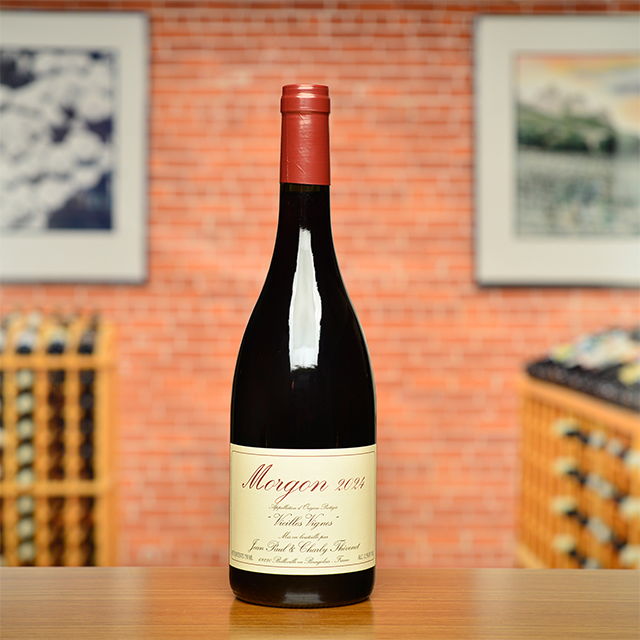Notify me
2017 Morgon “Les Charmes” Eponym’
Jean Foillard
Definitely a richer expression of Charmes, with a darker, more plummy quality; fruit at the peak of ripeness. There’s earthiness here, but with a plushness of texture I always associate with Foillard.
—Dustin Soiseth
| Wine Type: | red |
| Vintage: | 2017 |
| Bottle Size: | 750mL |
| Blend: | Gamay |
| Appellation: | Morgon |
| Country: | France |
| Region: | Beaujolais |
| Producer: | Jean Foillard |
| Winemaker: | Jean Foillard |
| Vineyard: | 45 - 50 years; 1.5 ha total |
| Soil: | Schist, Granite, Manganese |
| Farming: | Organic (certified) |
| Alcohol: | 14% |
More from this Producer or Region

2023 Beaujolais-Villages
France | Beaujolais
Silky and seductive, with notes of rose petals, red berries, and stones.

2024 Morgon “Vieilles Vignes”
France | Beaujolais
If Beaujolais were Burgundy, we might consider Morgon to be Vosne-Romanée, with its haunting perfume and silky texture, the proverbial iron fist in a velvet glove.

2023 Beaujolais Blanc “Clos de Rochebonne”
France | Beaujolais
Rochebonne offers Chardonnay fruit that’s both racy and sun-kissed

2023 Fleurie
France | Beaujolais
Light and living, charged with herbs, cranberry, and strawberry.

2018 Brouilly
France | Beaujolais
A generous dash of plump, sun-ripened fruit enveloping a granite core

2024 Beaujolais
France | Beaujolais
Tangy, thirst-quenching Gamay from a family that has been making Beaujolais for over 500 years. Violets, raspberry, and spice abound in this flavor-packed red that stays light on its feet.

2024 Beaujolais-Villages
France | Beaujolais
This drinks like a Gamay infusion with lovely hints of potpourri, spice, and fresh grapes.

2021 Brouilly
France | Beaujolais
A generous dash of plump, sun-ripened fruit enveloping a granite core.

2022 Côte de Brouilly
France | Beaujolais
A relatively new addition to Guy Breton’s Beaujolais lineup, this exuberant Côte de Brouilly is flat-out delicious.

2023 Morgon “Cuvée Corcelette”
France | Beaujolais
Sweet, earthy fruit and sensuous, velvety texture.
About The Producer
Jean Foillard
About The Region
Beaujolais

After years of the region’s reputation being co-opted by mass-produced Beaujolais Nouveau and the prevalence of industrial farming, the fortunes of vignerons from the Beaujolais have been on the rise in the past couple of decades. Much of this change is due to Jules Chauvet, a prominent Beaujolais producer who Kermit worked with in the 1980s and arguably the father of the natural wine movement, who advocated not using herbicides or pesticides in vineyards, not chaptalizing, fermenting with ambient yeasts, and vinifying without SO2. Chief among Chauvet’s followers was Marcel Lapierre and his three friends, Jean Foillard, Guy Breton, and Jean-Paul Thévenet—a group of Morgon producers who Kermit dubbed “the Gang of Four.” The espousal of Chauvet’s methods led to a dramatic change in quality of wines from Beaujolais and with that an increased interest and appreciation for the AOC crus, Villages, and regular Beaujolais bottlings.
The crus of Beaujolais are interpreted through the Gamay grape and each illuminate the variety of great terroirs available in the region. Distinguishing itself from the clay and limestone of Burgundy, Beaujolais soils are predominantly decomposed granite, with pockets of blue volcanic rock. The primary vinification method is carbonic maceration, where grapes are not crushed, but instead whole clusters are placed in a tank, thus allowing fermentation to take place inside each grape berry.
Much like the easy-going and friendly nature of many Beaujolais vignerons, the wines too have a lively and easy-drinking spirit. They are versatile at table but make particularly good matches with the local pork sausages and charcuterie. Though often considered a wine that must be drunk young, many of the top crus offer great aging potential.
More from Beaujolais or France
2023 Beaujolais Blanc “Clos de Rochebonne”
Château Thivin France | Beaujolais
2023 Moulin-à-Vent “Sous la Roche”
Domaine Thillardon France | Beaujolais
2024 Beaujolais “Le Beaujolais”
M. & C. Lapierre France | Beaujolais
2021 Beaujolais Blanc “Terrain Rouge”
Jean-Paul et Charly Thévenet France | Beaujolais
2024 Fleurie
Guy Breton France | Beaujolais
2022 Côte de Brouilly
Guy Breton France | Beaujolais
2025 Beaujolais Nouveau
La Sœur Cadette France | Beaujolais
2024 Beaujolais Blanc
Domaine Dupeuble France | Beaujolais
2025 Beaujolais Nouveau
Domaine Dupeuble France | Beaujolais
2023 Beaujolais-Villages
Jean Foillard France | Beaujolais
2021 Côte de Brouilly
Alex Foillard France | Beaujolais
2024 Beaujolais
Domaine Dupeuble France | Beaujolais
2023 Beaujolais Blanc “Clos de Rochebonne”
Château Thivin France | Beaujolais
2023 Moulin-à-Vent “Sous la Roche”
Domaine Thillardon France | Beaujolais
2024 Beaujolais “Le Beaujolais”
M. & C. Lapierre France | Beaujolais
2021 Beaujolais Blanc “Terrain Rouge”
Jean-Paul et Charly Thévenet France | Beaujolais
2024 Fleurie
Guy Breton France | Beaujolais
2022 Côte de Brouilly
Guy Breton France | Beaujolais
2025 Beaujolais Nouveau
La Sœur Cadette France | Beaujolais
2024 Beaujolais Blanc
Domaine Dupeuble France | Beaujolais
2025 Beaujolais Nouveau
Domaine Dupeuble France | Beaujolais
2023 Beaujolais-Villages
Jean Foillard France | Beaujolais
2021 Côte de Brouilly
Alex Foillard France | Beaujolais
2024 Beaujolais
Domaine Dupeuble France | Beaujolais
Vintage Chart Mentality

Vintage Chart Mentality
Trust the great winemakers, trust the great vineyards. Your wine merchant might even be trustworthy. In the long run, that vintage strip may be the least important guide to quality on your bottle of wine.—Kermit Lynch

















